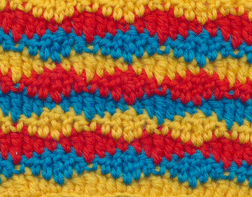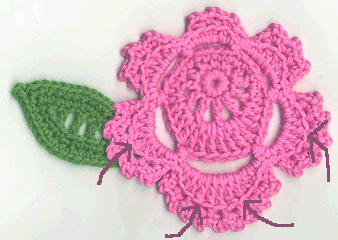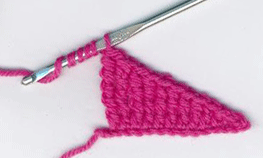American Half-Treble Crochet Stitch (htr)
By A Guest Writer – 34 CommentsA Guest Post by Suzann Thompson.
My Oma indulged a teenaged me by buying me German knitting and crochet magazines. (What a wonderful Oma!) I found a cute short-sleeved top with a wavy crochet stitch pattern: sc, hdc, dc, trc, dc, hdc, and repeat. We bought the yarn. I started crocheting.
It was just a small thing, but after the first row, I was bothered by the fact that the treble crochet stitches buckled. The difference in height between the double crochet and the treble was too large. Each treble had to bend to meet the double crochet stitch on each side of it.

See how the tall trc-sts pooch out in these two samples?
On the next row, the wavy pattern shifted so that the trebles had single crochets on them, and vice versa. This evened out the texture and the finished project looked fine. The issue of the buckling trc faded from my mind.

In the stitch pattern, each trc has its base in a valley, on top of a sc, so its height is diminished. No more buckling trc-sts.
Then, in the fall of 2006, the buckling trc returned to haunt me. I was designing flowers and leaves, trying to squeeze as much shaping as possible into a small space. There was often no second row or round to even out the texture. Suddenly the difference in height between the trc and dc was too much. I needed a stitch that was taller than a dc, but shorter than a trc.
We already have one intermediate stitch in the crochet arsenal: the half-double-crochet, or hdc. It makes the half-step transition between the sc and the dc. Following from that, it made sense that a stitch that steps up from a dc, yet is shorter than a trc, might be called a half-treble-crochet, or htr.
So how would a person make this so-called htr stitch? Once again, I turned to the hdc for inspiration. The hdc begins like a dc, only when you have three loops on the hook, you yarn over and pull through all three of the loops, instead of working them off two by two.

The arrows point to the htr-sts in the petals. Htr-sts smooth the transition from dc to trc in the lower petal. Htr is the tallest stitch in the side petals. It was the perfect height for those petals.
“I will start as if I’m going to make a trc,†I said to myself. “When I get to the point where I have three loops left on my hook, I’ll just yarn over and pull through all three. And that will be my htr!â€
It worked. The stitch was indeed about halfway between the dc and the trc in height. It was sturdier than the spindly trc. Here’s how to make the American htr:
- Yo twice. Insert hook in next stitch and draw up a loop (4 loops on hook)
- Yo and draw through two loops (3 loops on hook)
- Yo and draw through remaining loops (1 loop on hook)
“Why call this the American htr?†you may ask. Good question. Because there’s a British htr equivalent to the American hdc. The British term for the American htr would have to be “hdtr,†or half-double-treble.
Had I invented a new stitch? No, I felt certain that others had gone through the same thought process as I had.
Recently, I found out that one of the “others†was the incomparable Thèrése de Dillmont, author of The Complete Encyclopedia of Needlework (see Notes, below). In her chapter on crochet, under the section “Triple and quadruple trebles,†she writes:
When a series of gradually lengthening trebles is to be made, in every other treble the last [yarn]over is drawn through the last three loops…
…which is exactly how the htr is made: the last yarn over is drawn through the last three loops. But de Dillmont takes it further, suggesting the technique to produce half-steps between longer stitches, like double trebles and triple trebles. Who knows to which wobbly heights we can stretch this technique?

Htr and its taller friends create a smooth incline from sl st to quadruple treble.
de Dillmont ends the section by saying, “This variation in the length of trebles is often necessary for making flowers, leaves, indented edges, and scallops.â€
My thoughts exactly!
Suzann Thompson first published the htr in her book Crochet Bouquet (Lark, 2008). Her next crochet book also has htr sts in it. Look for it in the Spring of 2012. Suzann lives in rural Texas, surrounded by family, animals, yarn, and books. See more of Suzann’s work at http://www.textilefusion.com and please follow the links to her blogs.
Note: The Complete Encyclopedia of Needlework, by Thèrése de Dillmont, (Anniversary Edition, Running Press, Philadelphia, PA, 2002), pp. 284-285. This book uses British crochet terms.


Thank you for this very useful tip.Your flower and leaf design is beautiful.
I had this stitch (htr) come up in a pattern I was working on just a couple of weeks ago and had a very difficult time finding anything out about it. This is a terrific post!
Yes, I’ve heard about this stitch before. I learned about it in a book called “Crochet that fits,” by Mary Jane Hall. She uses half-triple, or half-“treble”, I call it triple. Anyway, she uses that and also uses half-double triple, which is like a double triple, but 3 loops are worked of last. I thought this stitch was nearly unheard of. Great post!
Sarah, Thank you for mentioning my book, Crochet That Fits. I’ve been seeing the htr and hdtr stitches allover the internet, and it was unheard of before my book care out. You never heard about it. I researched this from the oldest designers in the business (Rita Weis, Margaret Hubert and others) and none of them had heard of the htr and hdtr, so I developed it and introduced it in Crochet That Fits. I know I don’t own a copyright to stitches but it nice to have the credit.The same goes for my signature Graduated Stitch Method of making shaped garments without using in erases or decreases. (Copyrighted) Just wanted to say thanks!
Brilliant! Thanks for sharing!
What is “Crocht”
The late William (Bill) Elmore also “pioneered” elongated stitches. He is mentioned is my crochet books from the ’70s. So, it turns out he followed in the footsteps (footstitches ?) of Thérèse de Dilmont… 🙂
Di Sturgess “Crocht†is Crochet.
Great post and good info regarding the language differences! I am familiar with the htr (half treble crochet) stitch. It is actually one of the basic crochet stiches, which also means it can be done in the back loops or front loops for a different look or ribbed effect and still look great. Most patterns will not use a stich longer than a treble crochet. But if you are designing or experimenting you can make a stitch as long as you want. As a general rule, the longer the stitch, the more open the space will be between the stiches and the shorter the stitch, the tighter or firmer the piece will be. So depending on the thickness of the yarn, the size of the hook you are using and the desired effect, texture, or softness you want sometimes it is better to use a short(er) stitch and other times it is better to use a long(er) stitch.
The Complete Encyclopedia of Needlework, by Thèrése de Dillmont is available FREE and whole on Google Books. GREAT inspiration!
Thank you for the information.
Di, “crocht” is a yummy casserole made from yarn, kind of like Borscht, only better. Or it could be author proofreading failure–okay, that’s more likely.
I’m so glad to hear about all the “others” who have written about the htr and its relatives. It’s surprising that this stitch isn’t used more often. We’ll just have to have a htr-renaissance.
As a British Crocheter I understand a half treble to be what you would call a half double crochet?
yoh pull through, then yoh pull through three loops on hook.?
I thought this WAS an American dc for a while and made some things using this stitch. They worked out fine!
Hi Maggi!
The British half treble is indeed the American half double crochet. But the American half treble would be the same as a British half-double-treble. That’s why I wanted to be so careful to label it as the “American htr.” But it’s still confusing.
I’m glad your projects worked out, even with the language difference. I used to live in Sheffield, UK, and it was amazing to me how different the English language is from the American language.
Hello Rachel
I love your site and the fact that you are wiling to share your skill.
I am following an American site for flowers and it has instructions for 1htr followd by 1dc, then 1hdc.
Now when I look at your instructions for both htr and hdc, they look exactly the same?
Please can you let me know if they are different.
Thank you
Hi Peachick, the stitches are a little different.
The htr goes like this -> yarn over 2 times, insert hook in next stitch and draw up a loop (4 loops on hook), yarn over and draw through two loops on hook (3 loops on hook), yarn over and draw through remaining 3 loops on hook (1 loop on hook).
And the hdc goes like this -> yarn over 1 time, insert hook in next stitch and draw up a loop (3 loops on hook), yarn over and draw through all 3 loops on hook (1 loop on hook).
Hi Peachick!
The htr = yo twice, insert hook in your work and draw up a loop (4 loops on hook); yo and draw through 2 loops (3 loops remain on hook); yo and draw through remaining 3 loops.
The hdc = yo, insert hook in your work and draw up a loop (3 loops on hook); yo and draw through all loops on hook.
The htr is taller than the hdc, because it has more loops at the beginning.
Which site are you looking at, which has instructions for 1 htr, 1 dc, 1 hdc? That is a set of stitches that are descending in height, probably to give a certain shape to a flower petal or leaf or something.
Suzann
Dear Rachel and Suzann
Thank you both for your very clear and consice explanations.
I will try and let you know how I get on.
Suzann
I has looked at quite a few sites. I only found the instructions on Rachels site, but obviously I must have misread them.
Thanks Again
And apologies for the delay in my reply.
All the best
Peachick
Hi again, Peachick!
SInce you looked at quite a few sites, I wonder if you looked at some British sites and some American sites? On a British site, the htr would indeed be the same as an American hdc. It’s very confusing!
This is why I was very careful to call the htr described in this post an “American Htr.”
Happy crocheting!
Suzann
Hi Suzann
Yes, you’re right. I did work out that the hdc(uk) = htr(US). But now rachel has explained it, I will try and give it a go ………. soon.
Thanks Again
Peachick
How many do you chain before starting it?
Hi Asprin–
Chain 3 before starting a row of htr as it is described here.
Thanks for writing!
Suzann
thanks.
Just what I needed to find today. Everywhere was using the English htr which equates to the American hdc (half double crochet). Thanks very much for this post!
Yay! Glad we could help!
Thanks for the post. It was very helpful. I’m currently working on a pattern and it called for a htr and I was like “Huh?” never seen that before. I haven’t had to look up a “basic” stitch in a long time. Take care!
Thanks so much, this helped me adapt a pattern I was working on. Looks great!
Just today I was working on a vintage shawl that called for a “loop TR” stitch where the increases are made (I think it was to lessen the “cornering” effect of the increases. However, the stitch as worked was completely unsuitable, so I set about making a true Half TR —
NOT what the UK calls a half Tr. Very confusing.
Anyway, I came up with what you call the American half treble (love the name), and when I found your blog it confirmed me in what I had come up with. Thanks so much for sharing this. Our next step is to get it into more books than just yours. There is no reason on earth why this stitch should not be considered a standard. I couldn’t even find it in any of the books I have.
Great work, and keep it up.
What is a HTRB stitch in crochet?
Hi Carole.
I can only guess about this HTRB stitch, without being able to see the project or the instructions. Here goes:
1. HTRB could be a back-post htr, where you work around the post instead of in the top of the stitch, with your hook starting at the back of the work.
2. Since htr is so rare in U. S. patterns, it may more likely be a back-post British htr (American hdc).
Do either of these make sense for the pattern you are looking at?
Thanks for asking!
Suzann
Thank you so much for explaining this stitch! The difference in height between my (American) double crochets and triple crochets is quite a lot, and I thought to myself, “there *has* to be something in between”! Thankfully, there is, and you’ve helped me so much. Now my project will look much, *much* better. 🙂
Hi Alison!
I’m glad the article helped.
Probably lots of people have had the same thought over the years about a stitch between dc and tr. Thank goodness we have the internet now to help us communicate and find new crochet ideas!
Suzann
Thank you so much for your help.
I am having trouble finding a symbol for this stitch (or any half… treble stitch beyond this one). Does anyone know if there is a standard symbol for this stitch? I would like to be able to use it when creating patterns.
Thank you for the directions. I am preparing to make a few Christmas decorations and the Heart pattern called for this stitch.